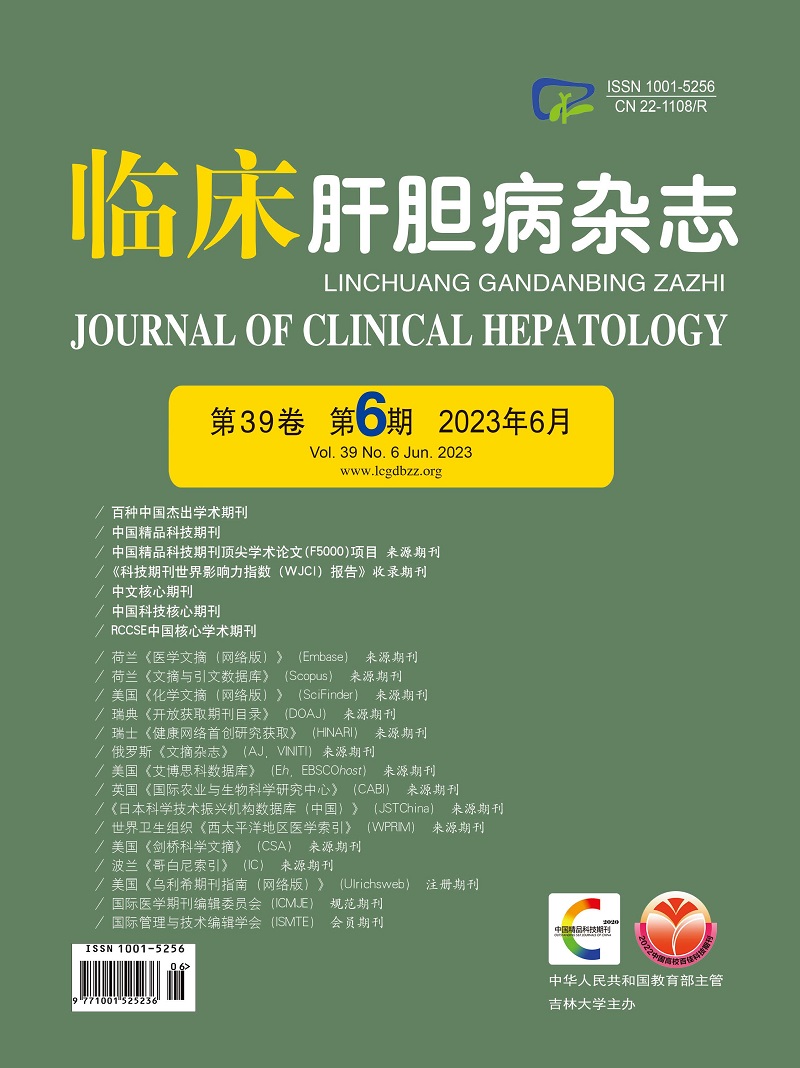| [1] |
ZHANG CY, YUAN WG, HE P, et al. Liver fibrosis and hepatic stellate cells: Etiology, pathological hallmarks and therapeutic targets[J]. World J Gastroenterol, 2016, 22(48): 10512-10522. DOI: 10.3748/wjg.v22.i48.10512. |
| [2] |
TRAUTWEIN C, FRIEDMAN SL, SCHUPPAN D, et al. Hepatic fibrosis: Concept to treatment[J]. J Hepatol, 2015, 62(1 Suppl): S15-S24. DOI: 10.1016/j.jhep.2015.02.039. |
| [3] |
HIGASHI T, FRIEDMAN SL, HOSHIDA Y. Hepatic stellate cells as key target in liver fibrosis[J]. Adv Drug Deliv Rev, 2017, 121: 27-42. DOI: 10.1016/j.addr.2017.05.007. |
| [4] |
ZHANG M, SERNA-SALAS S, DAMBA T, et al. Hepatic stellate cell senescence in liver fibrosis: Characteristics, mechanisms and perspectives[J]. Mech Ageing Dev, 2021, 199: 111572. DOI: 10.1016/j.mad.2021.111572. |
| [5] |
EZHILARASAN D, SOKAL E, NAJIMI M. Hepatic fibrosis: It is time to go with hepatic stellate cell-specific therapeutic targets[J]. Hepatobiliary Pancreat Dis Int, 2018, 17(3): 192-197. DOI: 10.1016/j.hbpd.2018.04.003. |
| [6] |
AYD 1N MM, AKÇAL 1 KC. Liver fibrosis[J]. Turk J Gastroenterol, 2018, 29(1): 14-21. DOI: 10.5152/tjg.2018.17330. |
| [7] |
SCHUPPAN D, ASHFAQ-KHAN M, YANG AT, et al. Liver fibrosis: Direct antifibrotic agents and targeted therapies[J]. Matrix Biol, 2018, 68-69: 435-451. DOI: 10.1016/j.matbio.2018.04.006. |
| [8] |
YANG HX, BAI YF, CHANG L, et al. Research progress on the resources and utilization of the Mongolian medicinal plant Cyperus genus[J]. Northwest Pharm J, 2020, 35(5): 779-784. DOI: 10.3969/j.issn.1004-2407.2020.05.031. |
| [9] |
LU C, LI Y, CUI Y, et al. Isolation and functional analysis of genes involved in polyacylated anthocyanin biosynthesis in Blue Senecio cruentus[J]. Front Plant Sci, 2021, 12: 640746. DOI: 10.3389/fpls.2021.640746. |
| [10] |
JAMES ANTONY JJ, ZAKARIA S, ZAKARIA R, et al. Biochemical analyses of Dendrobium Sabin Blue PLBs during cryopreservation by vitrification[J]. Physiol Mol Biol Plants, 2019, 25(6): 1457-1467. DOI: 10.1007/s12298-019-00703-2. |
| [11] |
ZHANG CY, YAN YX, GAO XY, et al. Mechanism of anti- hepatic fibrosis action of the monk's medicine seven flavors liver clearing powder: based on UHPLC-TOF-MS and network pharmacology methods[J]. J South Med Univ, 2021, 41(8): 1131-1141. DOI: 10.12122/j.issn.1673-4254.2021.08.02. |
| [12] |
LIANG J, MENG GSLM, YAN YX, et al. Study on the anti-hepatic fibrosis effect and mechanism of qiwei qinggan powder based on proteomics[J]. China Pharm, 2020, 31(11): 1294-1302. DOI: 10.6039/j.issn.1001-0408.2020.11.03. |
| [13] |
ZHANG CY, JIN R, YAN YX, et al. Exploring the mechanism of action of Bluebonnets against liver fibrosis based on pharmacodynamic and network pharmacological approaches[J]. China J Chin Mater Med, 2022, 47(13): 3609-3618. DOI: 10.19540/j.cnki.cjcmm.20220207.702. |
| [14] |
LUBECKA K, FLOWER K, BEETCH M, et al. Loci-specific differences in blood DNA methylation in HBV-negative populations at risk for hepatocellular carcinoma development[J]. Epigenetics, 2018, 13(6): 605-626. DOI: 10.1080/15592294.2018.1481706. |
| [15] |
TAO Y, WANG N, QIU T, et al. The role of autophagy and NLRP3 inflammasome in liver fibrosis[J]. Biomed Res Int, 2020, 2020: 7269150. DOI: 10.1155/2020/7269150. |
| [16] |
ZHANG M, ZANG S. T cells in fibrosis and fibrotic diseases[J]. Front Immunol, 2020, 11: 1142. DOI: 10.3389/fimmu.2020.01142. |
| [17] |
KOSTALLARI E, HIRSOVA P, PRASNICKA A, et al. Hepatic stellate cell-derived platelet-derived growth factor receptor-alpha-enriched extracellular vesicles promote liver fibrosis in mice through SHP2[J]. Hepatology, 2018, 68(1): 333-348. DOI: 10.1002/hep.29803. |
| [18] |
MATSUDA M, SEKI E. Hepatic stellate cell-macrophage crosstalk in liver fibrosis and carcinogenesis[J]. Semin Liver Dis, 2020, 40(3): 307-320. DOI: 10.1055/s-0040-1708876. |
| [19] |
KHOMICH O, IVANOV AV, BARTOSCH B. Metabolic hallmarks of hepatic stellate cells in liver fibrosis[J]. Cells, 2019, 9(1): 24. DOI: 10.3390/cells9010024. |
| [20] |
SHI Z, ZHANG K, CHEN T, et al. Transcriptional factor ATF3 promotes liver fibrosis via activating hepatic stellate cells[J]. Cell Death Dis, 2020, 11(12): 1066. DOI: 10.1038/s41419-020-03271-6. |
| [21] |
KAMM DR, MCCOMMIS KS. Hepatic stellate cells in physiology and pathology[J]. J Physiol, 2022, 600(8): 1825-1837. DOI: 10.1113/JP281061. |
| [22] |
WANG R, SONG F, LI S, et al. Salvianolic acid A attenuates CCl 4-induced liver fibrosis by regulating the PI3K/AKT/mTOR, Bcl-2/Bax and caspase-3/cleaved caspase-3 signaling pathways[J]. Drug Des Devel Ther, 2019, 13: 1889-1900. DOI: 10.2147/DDDT.S194787. |
| [23] |
WU H, CHEN G, WANG J, et al. TIM-4 interference in Kupffer cells against CCL4-induced liver fibrosis by mediating Akt1/Mitophagy signalling pathway[J]. Cell Prolif, 2020, 53(1): e12731. DOI: 10.1111/cpr.12731. |
| [24] |
XIE Y, SHI X, SHENG K, et al. PI3K/Akt signaling transduction pathway, erythropoiesis and glycolysis in hypoxia (Review)[J]. Mol Med Rep, 2019, 19(2): 783-791. DOI: 10.3892/mmr.2018.9713. |
| [25] |
PAPA A, PANDOLFI PP. The PTEN-PI3K axis in cancer[J]. Biomolecules, 2019, 9(4): 153. DOI: 10.3390/biom9040153. |
| [26] |
XIU AY, DING Q, LI Z, et al. Doxazosin attenuates liver fibrosis by inhibiting autophagy in hepatic stellate cells via activation of the PI3K/Akt/mTOR signaling pathway[J]. Drug Des Devel Ther, 2021, 15: 3643-3659. DOI: 10.2147/DDDT.S317701. |
| [27] |
LIU X, LIU W, DING C, et al. Taxifolin, extracted from waste larix olgensis roots, attenuates CCl4-induced liver fibrosis by regulating the PI3K/AKT/mTOR and TGF-β1/Smads signaling pathways[J]. Drug Des Devel Ther, 2021, 15: 871-887. DOI: 10.2147/DDDT.S281369. |














 DownLoad:
DownLoad:
